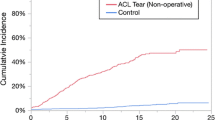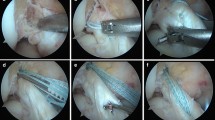Abstract
Purpose
Isolated posterior cruciate ligament (PCL) tears are an uncommon injury. The goals of this study are to (1) determine the population-based incidence of isolated PCL tears, (2) compare the occurrence of secondary meniscal tears or arthritis in patients with PCL deficiency to patients without PCL tears, and (3) evaluate factors associated with long-term sequelae among patients with PCL deficiency.
Methods
This retrospective study included a population-based incidence cohort of 48 patients with new-onset, isolated PCL tears between 1990 and 2010, as well as an age and sex-matched cohort of individuals without PCL tears. A chart review was performed to collect information related to the initial injury, treatment, and outcomes. Subjects were retrospectively followed to determine the development of subsequent meniscal tears, arthritis, or total knee arthroplasty (TKA).
Results
The age- and sex-adjusted annual incidence of isolated, complete PCL tears was 1.8 (95 % CI 1.3, 2.3) per 100,000. During a mean 12.2-year follow-up, patients with isolated PCL tears had a significantly higher likelihood (HR 6.2, 95 % CI 1.8, 21.2) of symptomatic arthritis compared to individuals without PCL tears. The likelihood of subsequent meniscal tears (HR 2.1, 95 % CI 0.4, 10.7) and TKA (HR 3.2, 95 % CI 0.5, 19.6) was more frequent among patients with PCL tears compared to subjects without PCL tears. Older age at injury was significantly associated with future arthritis (P = 0.003) and TKA (P = 0.02).
Conclusion
Isolated PCL tears remain a rare injury with an estimated annual incidence of 2 per 100,000 persons. Patients with isolated PCL tears have a significantly higher risk of symptomatic arthritis than patients without PCL tears. Older age at injury is associated with a higher risk of arthritis and the need for TKA. The results of this study can be used to educate patients about the natural history of isolated PCL tears and provide a baseline of expectations for the future development of arthritis and subsequent meniscal injury following isolated PCL injury.
Level of evidence
Retrospective comparative study, Level III.




Similar content being viewed by others
References
Cosgarea A, Jay P (2001) Posterior cruciate ligament injuries: evaluation and management. J Am Acad Orthop Surg 9:297–307
Fanelli G, Edson C (1995) Posterior cruciate ligament injuries in trauma patients: part II. Arthroscopy 11:526–529
Gill T, DeFrate L, Wang C, Carey C, Zayontz S, Zarins B, Li G (2004) The effect of posterior cruciate ligament reconstrucion of patellofemoral contact pressures in the knee joint under simulated muscle loads. Am J Sports Med 1:109–115
Keller P, Shelbourne D, McCarroll J, Rettig A (1993) Nonoperatively treated isolated posterior cruciate ligament injuries. Am J Sports Med 21:132–136
Konsei S, Horibe S, Nakata K, Maeda A, Hamada M, Nakamura N (1995) Conservative treatment of isolated injuries to the posterior cruciate ligament in athletes. J Bone Joint Surg Br 77:895–900
LaPrade C, Civitarese D, Rasmussen M, LaPrade R (2015) Emerging updates on the posterior cruciate ligament. Am J Sports Med 43:3077–3092
Li G, Gill T, DeFrate L, Zayontz S, Glatt V, Zarins B (2002) Biomechanical consequences of PCL deficiency in the knee under simulated muscle loads—an in vitro experimental study. J Orthop Res 4:887–892
Majewski M, Susanne H, Klaus S (2006) Epidemiology of athletic knee injuries: a 10-year study. Knee 13:184–188
Mariani P, Margheritini F, Christel P, Bellelli A (2005) Evaluation of posterior cruciate ligament healing: a study using magnetic resonance imaging and stress radiography. Arthroscopy 21:1354–1361
Mehta V, Paxton L, Fornalski S, Csintalan R, Fithian D (2007) Reliability of the international knee documentation committee radiographic grading system. Am J Sports Med 35:933–935
Melbourne D, Tietjens B (1996) Long-term follow up of the untreated isolated posterior cruciate ligament deficient knee. Am J Sports Med 24:306–310
Okazaki K, Takayama Y, Osaki K, Matsuo Y, Mizu-uchi H, Hamai S, Honda H, Iwamoto Y (2015) Subclinical cartilage degeneration in young athletes with posterior cruciate ligament injuries detected with T1p magnetic resonance imaging mapping. Knee Surg Sports Traumatol Arthrosc 23:3094–3100
Parolie J, Bergfeld J (1986) Long-term results of nonoperative treatment of isolated posterior cruciate ligament injuries in the athlete. Am J Sports Med 14:35–38
Patel D, Allen A, Warren R, Wickiewicz T, Simonian P (2007) The nonoperative treatment of acute, isolated (partial or complete) posterior cruciate ligament-deficient knees: an intermediate-term follow-up study. HSS J 3:137–146
Pearsall A, Hollis J (2004) The effect of posterior cruciate ligament injury and reconstruction on meniscal strain. Am J Sports Med 32:1675–1680
Rocca WA, Yawn BP, St Sauver JL, Grossardt BR, Melton LJ (2012) History of the Rochester Epidemiology Project: half a century of medical records linkage in a US population. Mayo Clin Proc 87:1202–1213
Schulz M, Russe K, Weilder A, Eichhorn H, Strobel M (2003) Epidemiology of posterior cruciate ligament injuries. Arch Orthop Trauma Surg 123:186–191
Shelbourne K, Clark M, Gray T (2013) Minimum 10-year follow-up of patients after an acute, isolated posterior cruciate ligament injury treated nonoperatively. Am J Sports Med 41:1526–1533
Shelbourne K, Davis T, Patel D (1999) The natural history of acute, isolated, nonoperatively treated posterior cruciate ligament injuries. A prospective study. Am J Sports Med 27:276–283
Shelbourne K, Muthukaruppan Y (2005) Subjective results of nonoperatively treated, acute, isolated posterior cruciate ligament injuries. Arthroscopy 21:457–461
St Sauver J, Grossardt B, Leibson C, Yawn B, Melton L, Rocca W (2012) Generalizability of epidemiological findings and public health decisions: an illustration from the Rochester Epidemiology Project. Mayo Clin Proc 87:151–160
St Sauver J, Grossardt B, Yawn B et al (2012) Data resource profile: the Rochester Epidemiology Project (REP) medical records-linkage system. Int J Epidemiol 41:1614–1624
St Sauver J, Grossardt B, Yawn B, Melton L, Rocca W (2011) Use of a medical records linkage system to enumerate a dynamic population over time: the Rochester Epidemiology Project. Am J Epidemiol 173:1059–1068
Watsend A, Osestad T, Jakobsen R, Engebretsen L (2009) Clinical studies on posterior cruciate ligament tears have weak design. Knee Surg Sports Traumatol Arthrosc 17:140–149
Wind W, Bergfeld J, Parker R (2004) Evaluation and treatment of posterior cruciate ligament injuries: revisited. Am J Sports Med 32:1765–1775
Acknowledgments
This study was made possible by the Rochester Epidemiology Project which is supported by the National Institute on Aging of the National Institutes of Health under award number R01AG034676. The findings and conclusions of this report are solely the responsibility of the authors and do not necessarily represent the official views of the National Institutes of Health.
Author information
Authors and Affiliations
Corresponding author
Rights and permissions
About this article
Cite this article
Sanders, T.L., Pareek, A., Barrett, I.J. et al. Incidence and long-term follow-up of isolated posterior cruciate ligament tears. Knee Surg Sports Traumatol Arthrosc 25, 3017–3023 (2017). https://doi.org/10.1007/s00167-016-4052-y
Received:
Accepted:
Published:
Issue Date:
DOI: https://doi.org/10.1007/s00167-016-4052-y




